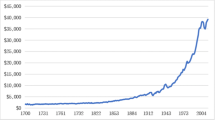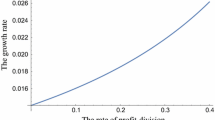Abstract
This paper develops an R&D-based growth model and calibrates the model to aggregate data of the US economy to quantify a structural relationship between patent length, R&D and consumption. Under parameter values that match the empirical flow-profit depreciation rate of patents and other key features of the US economy, extending the patent length beyond 20 years leads to a negligible increase in R&D despite equilibrium R&D underinvestment. In contrast, shortening the patent length leads to a significant reduction in R&D and consumption. Finally, this paper also analytically derives and quantifies a dynamic distortionary effect of patent length on capital investment.
Similar content being viewed by others
References
Acemoglu D (2009) Introduction to modern economic growth. Princeton University Press, Princeton
Basu S, Fernald J (1997) Returns to scale in U.S. production: estimates and implications. J Political Econ 105: 249–283
Bessen J (2008) The value of U.S. patents by owner and patent characteristics. Res Policy 37: 932–945
Chou CF, Shy O (1993) The crowding-out effects of long duration of patents. RAND J Econ 24: 304–312
Chu A (2009) Effects of blocking patents on R&D: a quantitative DGE analysis. J Econ Growth 14: 55–78
Comin D (2004) R&D: a small contribution to productivity growth. J Econ Growth 9: 391–421
Futagami K, Iwaisako T (2003) Patent policy in an endogenous growth model. J Econ 78: 239–258
Futagami K, Iwaisako T (2007) Dynamic analysis of patent policy in an endogenous growth model. J Econ Theory 132: 306–334
Gallini N (2002) The economics of patents: lessons from recent U.S. patent reform. J Econ Perspectives 16: 131–154
Jaffe A (2000) The U.S. patent system in transition: policy innovation and the innovation process. Res Policy 29: 531–557
Jaffe A, Lerner J (2004) Innovation and its discontents: how our broken system is endangering innovation and progress, and what to do about it. Princeton University Press, Princeton
Jones C (1995a) Time series tests of endogenous growth models. Q J Econ 110: 495–525
Jones C (1995b) R&D-based models of economic growth. J Political Econ 103: 759–784
Jones C (1999) Growth: with or without scale effects. Am Econ Rev 89: 139–144
Jones C, Williams J (1998) Measuring the social return to R&D. Q J Econ 113: 1119–1135
Jones C, Williams J (2000) Too much of a good thing? The economics of investment in R&D. J Econ Growth 5: 65–85
Judd K (1985) On the performance of patents. Econometrica 53: 567–586
Krusell P (1998) Investment-specific R&D and the decline in the relative price of capital. J Econ Growth 3: 131–141
Kwan YK, Lai E (2003) Intellectual property rights protection and endogenous economic growth. J Econ Dyn Control 27: 853–873
Laitner J (1982) Monopoly and long-run capital accumulation. Bell J Econ 13: 143–157
Laitner J, Stolyarov D (2004) Aggregate returns to scale and embodied technical change: theory and measurement using stock market data. J Monet Econ 51: 191–233
Lanjouw J (1998) Patent protection in the shadow of infringement: simulation estimations of patent value. Rev Econ Stud 65: 671–710
Ngai R, Samaniego R (2009) Accounting for research and productivity growth across industries. Rev Econ Dyn (in press)
Nordhaus W (1969) Invention, growth, and welfare. MIT Press, Cambridge
O’Donoghue T, Zweimuller J (2004) Patents in a model of endogenous growth. J Econ Growth 9: 81–123
Pakes A (1986) Patents as options: some estimates of the value of holding European patent stocks. Econometrica 54: 755–784
Rivera-Batiz L, Romer P (1991) Economic integration and endogenous growth. Q J Econ 106: 531–555
Romer P (1990) Endogenous technological change. J Political Econ 98: S71–S102
Schankerman M, Pakes A (1986) Estimates of the value of patent rights in European countries during the post-1950 period. Econ J 96: 1052–1076
Scotchmer S (2004) Innovation and incentives. MIT Press, Cambridge
Author information
Authors and Affiliations
Corresponding author
Additional information
The previous version of this paper was circulated under the title “Economic Growth and Patent Policy: Quantifying the Effects of Patent Length on R&D and Consumption”.
Rights and permissions
About this article
Cite this article
Chu, A.C. Effects of patent length on R&D: a quantitative DGE analysis. J Econ 99, 117–140 (2010). https://doi.org/10.1007/s00712-010-0110-y
Received:
Accepted:
Published:
Issue Date:
DOI: https://doi.org/10.1007/s00712-010-0110-y




